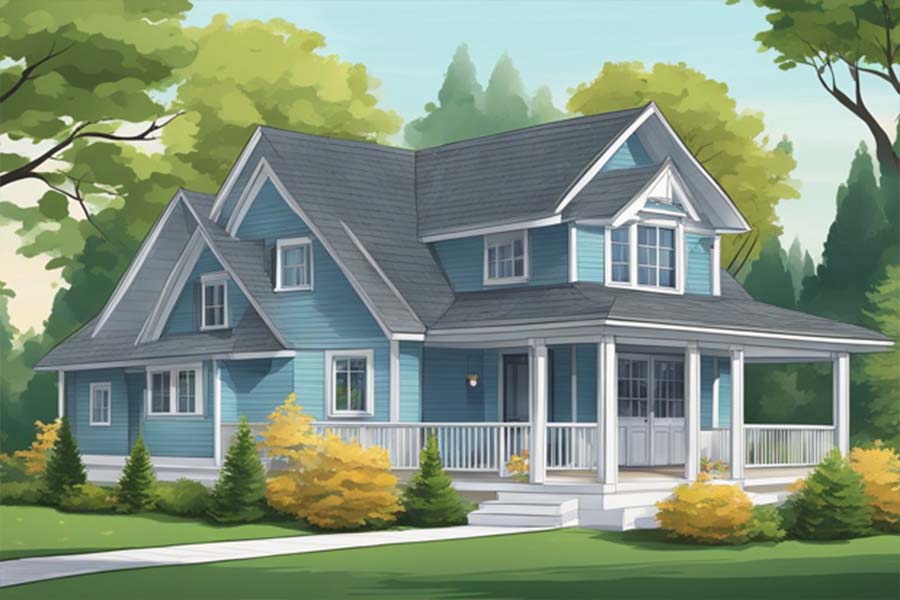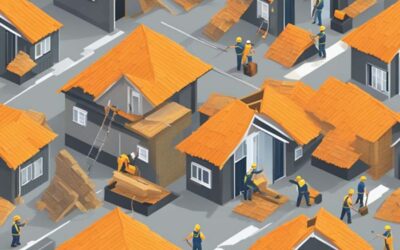Roofs are an essential part of any building, protecting it from the elements and providing shelter to its occupants. However, many people take their roofs for granted and neglect to maintain them properly. This can lead to a shortened lifespan for the roof and costly repairs or replacement down the line.
Understanding the lifespan of a roof is crucial for any property owner. The lifespan of a roof can vary greatly depending on factors such as the type of roofing material, climate, and maintenance. For example, a well-maintained asphalt shingle roof can last up to 30 years, while a poorly maintained one may only last 15 years. By understanding the factors that affect roof lifespan, property owners can take proactive steps to ensure their roofs last as long as possible.
Factors Influencing Roof Lifespan
Several factors influence the lifespan of a roof, including the type of material used, the quality of installation, and the level of maintenance it receives. Here are some of the most important factors that affect the longevity of a roof:
1. Type of Material
The type of material used for the roof plays a significant role in determining its lifespan. For example, asphalt shingles typically last between 15 and 25 years, while metal roofs can last up to 50 years or more. Other materials, such as clay tiles and slate, can last even longer with proper maintenance. It’s important to choose a material that is appropriate for the climate and weather conditions in your area.
2. Quality of Installation
The quality of installation is just as important as the material used. Poor installation can lead to leaks, gaps, and other problems that can shorten the lifespan of the roof. It’s important to hire a reputable contractor with experience in installing the type of roof you have chosen.
3. Level of Maintenance
Regular maintenance is essential for extending the lifespan of a roof. This includes inspecting the roof for damage, cleaning gutters and downspouts, and repairing any issues promptly. Neglecting maintenance can lead to more significant problems down the line, such as water damage, mold growth, and structural damage.
4. Climate and Weather Conditions
The climate and weather conditions in your area can also impact the lifespan of your roof. For example, areas with high winds, heavy rain, or extreme temperatures may require more frequent maintenance and repairs. It’s important to choose a material that is appropriate for the climate and to take steps to protect the roof from weather-related damage.
In conclusion, understanding the factors that influence roof lifespan is crucial for homeowners and property managers. By choosing the right material, hiring a reputable contractor, and maintaining the roof properly, you can ensure that your roof lasts as long as possible.
Regular Maintenance and Its Impact
Regular maintenance is crucial to extending the lifespan of a roof. By performing routine inspections and addressing any issues promptly, homeowners can prevent small problems from turning into major repairs.
One of the most important aspects of regular maintenance is keeping the roof clean. Debris, such as leaves, branches, and dirt, can accumulate on the roof and in gutters, which can cause water to pool and lead to leaks. Regular cleaning can prevent this buildup and ensure proper drainage.
In addition to cleaning, regular inspections should be performed to identify any damage or wear and tear. This includes checking for cracked or missing shingles, damaged flashing, and any signs of water damage. By catching these issues early, homeowners can prevent further damage and extend the life of their roof.
Another important aspect of regular maintenance is addressing any issues promptly. Even minor problems, such as a small leak, can quickly escalate if left unchecked. By addressing issues as soon as they arise, homeowners can prevent costly repairs and extend the lifespan of their roof.
Overall, regular maintenance is essential to ensuring the longevity of a roof. By performing routine inspections, keeping the roof clean, and addressing any issues promptly, homeowners can prevent small problems from turning into major repairs and extend the lifespan of their roof.
Common Roofing Materials and Durability
When it comes to roofing materials, there are several options available in the market. Each material has its own unique properties that determine its durability and lifespan. In this section, we will discuss some of the most common roofing materials and their expected lifespan.
Asphalt Shingles
Asphalt shingles are the most popular roofing material in North America due to their affordability and ease of installation. They are made from a combination of fiberglass and asphalt and are available in a variety of colors and styles. The lifespan of asphalt shingles ranges from 15 to 30 years, depending on the quality of the shingles and the climate in which they are installed.
Metal Roofing
Metal roofing is becoming increasingly popular due to its durability and energy efficiency. Metal roofs are made from steel, aluminum, or copper and can last up to 50 years or more with proper maintenance. They are resistant to fire, wind, and hail, making them an ideal choice for areas prone to severe weather conditions.
Clay and Concrete Tiles
Clay and concrete tiles are popular in areas with a warm climate due to their ability to reflect sunlight and keep homes cool. They are durable and can last up to 50 years or more with proper maintenance. However, they are heavy and require a strong roof structure to support them.
Slate Roofing
Slate roofing is known for its beauty and longevity. It is made from natural stone and can last up to 100 years or more with proper maintenance. However, it is expensive and requires a skilled professional to install.
Wood Shingles and Shakes
Wood shingles and shakes are popular in areas with a rustic or traditional architectural style. They are made from cedar, redwood, or pine and can last up to 30 years with proper maintenance. However, they are prone to rot and decay and require regular treatment to prevent damage.
In conclusion, the choice of roofing material depends on various factors such as budget, climate, and personal preference. It is important to choose a material that is durable and can withstand the weather conditions in your area. Regular maintenance is also essential to ensure the longevity of your roof.
Environmental Effects on Roof Longevity
The lifespan of a roof is heavily influenced by the environment in which it is located. Extreme weather conditions, such as high winds, heavy rain, snow, and hail, can cause damage to the roof’s structure and materials. Additionally, exposure to UV rays from the sun can cause deterioration and discoloration of the roof.
In areas with high levels of air pollution, the roof can become stained and discolored, reducing its aesthetic appeal. This can also lead to the growth of moss and algae, which can cause further damage to the roof’s surface.
Furthermore, the presence of nearby trees can also affect the lifespan of a roof. Falling branches, leaves, and other debris can damage the roof’s structure and materials. Additionally, overhanging branches can provide a pathway for animals and pests to access the roof, leading to further damage.
Regular maintenance and cleaning of the roof can help mitigate these environmental effects and prolong the roof’s lifespan. This includes removing debris, cleaning stains and discoloration, and repairing any damage as soon as it is noticed. Homeowners should also consider installing protective coatings or materials, such as UV-resistant shingles, to help prevent damage from the sun’s rays.
Overall, understanding the environmental factors that can affect a roof’s lifespan is crucial for homeowners and building managers to ensure the longevity and durability of their roofing system.
Warning Signs and Preventive Measures
Regular maintenance is key to extending the lifespan of a roof. Here are some warning signs to look out for and preventive measures to take:
Warning Signs:
- Missing or cracked shingles
- Leaks or water damage inside the building
- Sagging or uneven roofline
- Excessive debris on the roof
- Damaged flashing or vents
If any of these warning signs are present, it is important to address them promptly to prevent further damage to the roof and the building.
Preventive Measures:
- Regular inspections: Inspect the roof at least twice a year, preferably in the spring and fall, to catch any issues early on.
- Keep the roof clean: Remove debris such as leaves, branches, and other materials that can accumulate on the roof and cause damage.
- Trim trees: Trim any overhanging branches that can scratch or damage the roof during high winds or storms.
- Address issues promptly: If any warning signs are present, address them promptly to prevent further damage.
- Hire a professional: Consider hiring a professional roofing contractor to perform maintenance and repairs on the roof.
By taking these preventive measures and addressing warning signs promptly, building owners can extend the lifespan of their roof and prevent costly repairs down the road.
Professional Inspections and Their Importance
Regular professional inspections are crucial to maintaining the longevity of a roof. A professional roofing contractor has the knowledge and expertise to identify potential issues that may not be visible to the untrained eye.
During an inspection, the contractor will thoroughly examine the roof, checking for any signs of damage or wear and tear. They will also inspect the flashing, gutters, and downspouts to ensure that they are all functioning properly.
It is recommended that roofs be inspected at least once a year, preferably in the spring or fall. This allows the contractor to identify any issues before they become major problems, potentially saving the homeowner thousands of dollars in repairs.
In addition to identifying potential issues, regular inspections can also help to extend the life of a roof. By catching and repairing minor issues early on, the roof can continue to perform at its best for many years to come.
Overall, professional inspections are an essential part of roof maintenance. They provide homeowners with peace of mind, knowing that their roof is in good hands and will continue to protect their home for years to come.
Maintenance Tips for Homeowners
Regular maintenance is essential to prolonging the lifespan of a roof. Here are some tips for homeowners to help maintain their roofs:
Inspect Your Roof Regularly
Homeowners should inspect their roofs at least twice a year. Inspections should be done in the spring and fall to check for any damage caused by winter weather or storms. Look for any signs of damage such as missing or broken shingles, cracks, or leaks. If you notice any damage, it is important to address the issue as soon as possible to prevent further damage.
Keep Your Gutters Clean
Clogged gutters can cause water to back up and damage your roof. Homeowners should clean their gutters at least twice a year, in the spring and fall. Remove any leaves or debris that may have accumulated in the gutters. This will allow water to flow freely and prevent damage to your roof.
Trim Overhanging Branches
Overhanging branches can cause damage to your roof during storms or high winds. Homeowners should trim any overhanging branches that are close to their roof. This will prevent them from falling onto the roof and causing damage.
Hire a Professional
If you are not comfortable inspecting or maintaining your roof, it is best to hire a professional. A roofing contractor can inspect your roof and identify any issues that need to be addressed. They can also perform any necessary repairs or maintenance to ensure that your roof lasts as long as possible.
By following these maintenance tips, homeowners can help prolong the lifespan of their roof and prevent costly repairs.
The Cost-Benefit Analysis of Roof Upkeep
Regular maintenance of a roof is essential to extend its lifespan and prevent costly repairs or replacements. However, some property owners may question the cost-effectiveness of investing in roof upkeep. This section will explore the cost-benefit analysis of roof maintenance and provide insights into why it is a worthwhile investment.
Benefits of Roof Upkeep
The primary benefit of roof upkeep is that it extends the lifespan of the roof. Regular inspections and maintenance can identify and address minor issues before they become major problems. This can save property owners from the high cost of a full roof replacement, which can run into tens of thousands of dollars.
Roof upkeep also helps to prevent leaks and water damage. A leaky roof can cause significant damage to the structure of a building, as well as its contents. Water damage can lead to mold growth, which can be hazardous to health and expensive to remediate. Regular maintenance can prevent leaks and water damage, protecting both the building and its occupants.
Costs of Roof Upkeep
The cost of roof upkeep varies depending on the size and type of the roof, as well as the extent of the maintenance required. However, the cost of regular maintenance is typically much lower than the cost of major repairs or replacement.
The cost of roof upkeep can be further reduced by scheduling maintenance during the off-season when contractors are less busy and may offer discounts. Property owners can also save money by performing some maintenance tasks themselves, such as cleaning gutters and removing debris from the roof.
Conclusion
In conclusion, the cost-benefit analysis of roof upkeep clearly demonstrates that investing in regular maintenance is a wise decision. The benefits of extending the lifespan of the roof and preventing costly repairs far outweigh the relatively low cost of upkeep. Property owners who prioritize roof maintenance can enjoy peace of mind knowing that their building is protected and their investment is secure.





0 Comments